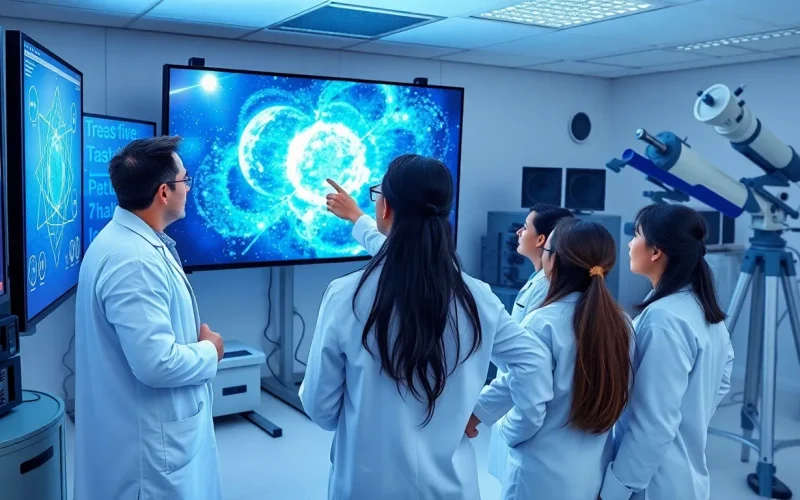Table of Contents
ToggleIn a universe overflowing with stars, planets, and cosmic mysteries, space data analysis is the unsung hero that helps decode the celestial symphony. Imagine trying to find a needle in a galactic haystack—without the right tools, it’s a cosmic comedy of errors. Fortunately, experts wield advanced analytics like space wizards, transforming raw data into insights that even your pet goldfish would understand.
Overview Of Space Data Analysis
Space data analysis involves processing extensive datasets collected from various space missions and telescopes. Experts utilize methods such as statistical analysis, machine learning, and data visualization to extract insights. These techniques help researchers understand phenomena like galaxy formation, exoplanet discovery, and cosmic microwave background radiation.
Data sources for space analysis include satellite imagery, radar signals, and spectrographic measurements. Raw data from these sources often require significant cleaning and transformation. Once processed, this data reveals patterns and trends previously hidden in the complexities of the universe.
Advanced analytical tools play a crucial role in space data analysis. Tools such as Python libraries, R, and specialized software enable scientists to perform intricate computations and simulations. Visualization platforms help present complex data in an understandable format, allowing for intuitive interpretations.
Applications of space data analysis are vast and varied. They encompass tasks such as monitoring climate change effects through satellite imagery and tracking asteroids that may pose risks to Earth. In astronomy, this analysis aids in mapping celestial objects and studying their behaviors over time.
Space data analysis fosters collaborations across disciplines and institutions. Researchers combine expertise from fields such as physics, computer science, and engineering. Enhanced collaboration allows for sharing knowledge and refining techniques, ultimately leading to groundbreaking discoveries in understanding the universe.
Importance Of Space Data Analysis

Space data analysis plays a vital role in deciphering complex cosmic phenomena. Experts leverage advanced techniques to transform raw data into valuable insights that advance our understanding of the universe.
Applications In Astronomy
Astronomy benefits immensely from space data analysis. Researchers utilize statistical methods and machine learning to study galaxy formations and detect exoplanets. Data collected from telescopes and space missions leads to the identification of celestial bodies and comprehending their properties. Visualization tools assist in presenting intricate findings clearly, making them accessible to both scientists and enthusiasts. Space data informs theories related to dark matter and energy, contributing significantly to the field’s ongoing evolution.
Applications In Earth Science
Monitoring Earth’s environment relies heavily on space data analysis. Satellite imagery provides crucial insights into climate change impacts, such as melting ice caps and shifting weather patterns. Researchers apply data analytics to enhance predictive models for natural disasters, improving preparation and response efforts. Collaboration between disciplines such as meteorology and environmental science enriches research outcomes. Space-based data also aids in agricultural planning, assisting farmers in optimizing crop yields and managing resources effectively.
Tools And Technologies
Space data analysis relies on various tools and technologies to process and interpret extensive datasets. Software solutions and advanced data processing techniques form the backbone of this analytical field, enabling researchers to uncover significant insights.
Software Solutions
Python libraries such as NumPy and Pandas facilitate numerical analysis and data manipulation. R offers robust statistical capabilities, allowing for comprehensive data exploration. Specialized software like MATLAB excels in handling complex simulations. Visualization platforms, including Tableau and Matplotlib, enable scientists to present findings in intuitive formats. These software solutions assist not only in data processing but also in enhancing collaboration among researchers.
Data Processing Techniques
Statistical analysis serves as a fundamental technique in space data analysis, providing essential insights into data distributions. Machine learning algorithms help identify patterns within noisy datasets. Data cleaning processes ensure accuracy by removing errors and inconsistencies. Techniques such as clustering and regression analyses further support in-depth investigations of cosmic phenomena. Visual data representation aids in simplifying complex results, making it easier for both experts and enthusiasts to grasp intricate findings.
Challenges In Space Data Analysis
Space data analysis faces several significant challenges. Data volume and complexity often overwhelm traditional processing techniques.
Data Volume And Complexity
Astronomy generates vast amounts of data daily. Satellites, telescopes, and other instruments continuously capture high-resolution images and measurements. Processing such extensive datasets requires advanced algorithms and robust computational resources. Researchers frequently encounter difficulties in cleaning and organizing data to extract meaningful insights. For example, signals from cosmic phenomena may contain noise that obstructs clear analysis. Achieving accuracy in analyses becomes an ongoing challenge due to this complexity. Efficient data handling methods must evolve alongside growing technological capabilities.
Integration Of Diverse Data Sources
Integrating diverse data sources presents another hurdle in space data analysis. Data comes from various instruments, including optical telescopes, radio arrays, satellite imagery, and more. Each source often follows its unique format and standard. Harmonizing these different datasets to create a coherent analytical framework challenges researchers significantly. Additionally, discrepancies in data quality further complicate integration efforts. A unified approach to standardization helps mitigate these issues, allowing for more comprehensive analyses. Employing machine learning techniques can assist in identifying patterns across disparate data sets and enhancing overall data synergy.
Future Trends In Space Data Analysis
Space data analysis continues to evolve rapidly, with promising developments on the horizon. Innovations in machine learning and data visualization are expected to reshape how researchers gain insights from cosmic data.
Advancements In Machine Learning
New machine learning algorithms enhance the ability to analyze vast cosmic datasets. Techniques like deep learning allow for improved pattern recognition in galaxy formation and exoplanet detection. Researchers increasingly rely on these advanced models to identify subtle signals hidden within large volumes of noise. Breakthroughs in unsupervised learning enable the exploration of uncharted cosmic phenomena, uncovering relationships that traditional methods might miss. Improved training datasets further elevate accuracy and efficiency in predictive modeling.
Enhanced Data Visualization
Innovative visualization tools offer clearer interpretations of complex datasets. These platforms enable researchers to communicate findings effectively, making large amounts of data more digestible. Interactive dashboards and 3D simulations enhance user engagement and facilitate exploratory data analysis. Visual storytelling, using graphics and animations, helps researchers emphasize key discoveries, drawing interest from a broader audience. Integration of AR and VR technologies further immerses users in data, fostering a deeper understanding of cosmic structures. Enhanced data visualization promises to bridge gaps between scientific research and public engagement.
Space data analysis stands at the forefront of scientific discovery. By transforming raw cosmic data into actionable insights, it enables researchers to unravel the mysteries of the universe and monitor Earth’s changing environment. The integration of advanced analytical tools and innovative visualization techniques enhances understanding and fosters collaboration across disciplines.
As machine learning and data visualization continue to evolve, the potential for groundbreaking discoveries expands. These advancements not only improve the accuracy of analyses but also make complex findings accessible to a wider audience. The future of space data analysis promises to deepen our knowledge of both the cosmos and our planet, paving the way for new explorations and understanding.





